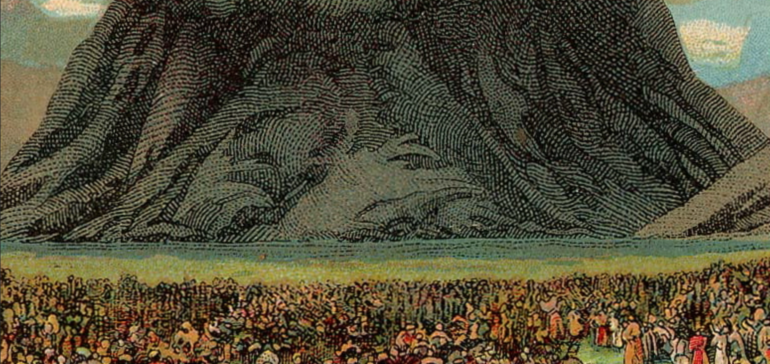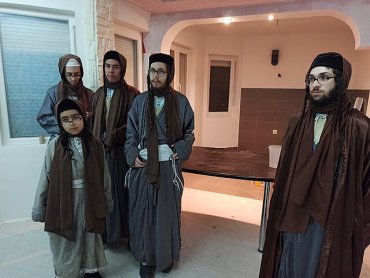
What Does It Mean that Every Soul Was at Mount Sinai When We Received the Torah?
Dear Jew in the City-
What does it mean that every soul was at Har Sinai but there are more Jews today then there were then?
Thank you,
Shanie
Dear Shanie-
Thanks for your question. You seem to understand that midrash to suggest that all the souls were there bodily but I don’t think that’s the intention. Let’s take a look at the source of the idea.
The gemara in Shabbos (146a) tells us that when Chava was tricked by the serpent, mankind became infected with a moral defect. When the Jews stood at Sinai, they were cleansed of this defect. Rav Acha asks, “What about converts?” Rav Ashi responded that even though future converts were not themselves at Sinai, their “mazels” were. (A mazel is a protective spiritual force – a “guardian angel” if you will.) To support this assertion, he cites Deuteronomy 29:13-14, “Not only with you do I make this covenant and this oath, but with one who stands here with us today before Hashem our God, and with one who is not here with us today.” The one who was not present refers to converts.
Savvy readers will note that the verses in Deuteronomy 29 aren’t talking about Sinai, they’re talking about the plains of Moav, so how does it prove anything about Sinai? The Baal HaTurim on Deuteronomy 29:9 points out that the Torah uses parallel language when talking about Sinai and the plains of Moav, so presumably the Sages considered the concepts fungible.
This only addresses the concept of converts, so how do we know about future generations of born Jews? This idea can be found in other versions of the midrash.
In Shemos Rabbah 28:6, Rav Yitzchak tells us that every prophecy the Neviim would convey in the future generations was received at Sinai as per the aforementioned Deuteronomy 29:14, “with one who stands here with us today before Hashem our God, and with one who is not here with us today.” The Torah doesn’t say “one who is not standing here with us today,” it says, “one who is not here with us today.” This refers to souls that would be created in the future; since they have no physical form, they can’t be said to stand. Even though they weren’t present, each of them received his share in Torah. The future prophets weren’t the only ones who received at Sinai the Torah knowledge that they were to share. The Torah scholars who would arise in each generation also received the wisdom they were to share.
Closer, I think, but still not quite there yet. Let’s look at one more source.
Midrash Tanchuma on Nitzavim comments on Deuteronomy 29:13: “not only with you.” Even future generations were present at Sinai. Why does the Torah say “one who is here” and “one who is not here?” Because all souls were there. The bodies of future generations were not yet created, however, which is why it doesn’t say “standing” vis-à-vis future generations.
There we go! I think this version says most explicitly the idea to which our question-submitter referred. (It should be noted that versions of this midrash appear in still more places beyond those I’ve cited. See, for example, Shevuos 39a et al.)
Many people use this midrash to suggest that this is the reason future generations are obligated in the Torah: because we all accepted it at Sinai. The Abarbanel strenuously objects to this conclusion. He writes that mitzvos only apply to a soul when it’s inside a body, i.e., a person. Leviticus 18:5 says that the mitzvos are for us to live by, which excludes the dead (and, presumably, the not-yet-born). In short, a soul cannot accept an obligation that would be binding upon its future incarnation.
This shouldn’t cause us any difficulty if we don’t base our faith on the historicity of midrashim. As I write elsewhere, most midrashim aren’t intended to be taken literally. In fact, many midrashim are contradictory so one couldn’t accept them all as literal history. Rather, they’re intended to impart moral lessons. So what lesson does this midrash teach us?
The version that focuses on converts teaches an important lesson: that converts are just as Jewish as those who are born that way.
The version that focuses on future prophets and scholars teaches another important lesson: that future Torah knowledge is authoritative because it’s rooted in Sinai.
From the midrash that says we were all at Sinai spiritually if not physically, I infer the lesson that all generations have an equally valid claim to the Torah, not just those who were there bodily to receive it.
Now, the Abarbanel, in dismissing some people’s conclusion to this midrash, cites an opinion that the 600,000 people who stood at Sinai represented all their descendants’ physical potential. (There were 600,000 adult men; with women and children, the total was more like 2 million.) This may be the assumption you were working under when asking your question. While it might be possible to reconcile (each person representing more than one potential descendant), it’s not necessary. If the Abarbanel doesn’t see the need to take every midrash literally, neither do I. Rather, look for the lesson that the midrash seeks to impart. That’s the way to find real significance in the words of our Sages.
Sincerely,
Rabbi Jack Abramowitz
Educational Correspondent
Follow Ask Rabbi Jack on YouTube
If you found this content meaningful and want to help further our mission through our Keter, Makom, and Tikun branches, please consider becoming a Change Maker today.







